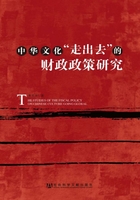
Abstract
Nowadays,the world is undergoing development,revolution and adjustment. Multi-polarization,economic globalization and cultural diversification are all happening. Science and technology are changing quickly,all kinds of thoughts and cultures frequently exchange and blend. The status and effects of culture in the competition of comprehensive national strength are becoming prominent. The competition for dominance in world development is becoming more intense. The task of maintaining national cultural security is also more difficult. The need to enhance national cultural soft power is more urgent. At the same time,China is going through broad and profound social transformation. Development opportunity,reform breakthrough and growing conflicts coexist. Thus,without active cultural guidance,and rich spiritual life of the people,it is impossible for a country and its people to stand tall in the world. Therefore,Chinese culture must “go global” quickly so that China can gain new development strength against the background of globalization.
Chapter One summarizes existing literature on Chinese culture “going global”. In China,research on this topic only began about ten years ago. The amount of research achievements is very limited. There in still less policy research on Chinese culture going out. And international data are relatively abundant. Even though countries differ in their cultural systems,cultural substance,and emphases in cultural industries,the following commonalities eist. First,the strength of culture reflects the country’s soft power and has strategic siguificance in this era of globalization;Secondly,the development of culture cannot happen without the supported from the government.
The second chapter analyzes the deeper motives behind supporting the Chinese culture “going global” from three aspects. First,from the theoretical aspect,cultural products have the features of ideology and positive externality. Their system of demand and supply is not the same as other types of products. The government should be actively in promoting culture “going global”. Secondly,realistically speaking,the “going global” strategy allows foreigners to know China better and help to avoid foreign invasion of Chinese culture and maintain cultural security. Thirdly,from the point of view of necessity and feasibility of finance support,the development of public finance and cultural innovations are consistent with each other. Supporting cultural reform and promoting Chinese culture’s reaching out to the world are important functions of public finance.
The third chapter analyzes the current situation of Chinese culture “going global” from the points of view of the government,enterprises and NGOs. From the point of view of the government,several departments have allocated different kinds of culture resources,and have tried to improve cultural communication. And the current reform of cultural institutions has provided inexhaustible fuel for the “going global” campaign. From the point of view of the enterprises,the author analyzes the current situation of the publishing,film,animation and performing arts industries and points out present problems. From the point of view of NGO’s,Confucius Institute,as a non-profit educational institution,enhances the knowledge of Chinese language and culture among people all over the world,and fully displays the unique charm of the Chinese culture.
The fourth chapter analyzes policies related to Chinese culture “going global”. First,since the start of the new century,China support cultural development policy and this analysis provides macro-level policy basis for the next analysis. Secondly,increasing the financial investment to the cultural institutions is the main form of fiscal support for Chinese culture to “go global”,and also the basic condition for sustained and healthy development for the cultural industry. This chapter analyzes financial investment in terms of its scale,structure and methods. Thirdly,as an important part of the national economic system,its preferential tax policies are beneficial to cultural enter by helping them prises participate in international competition and Chinese cultural products and services enter the international market. This chapter analyzes the preferential policy support and preferential taxes. Lastly,the cultural finance of our country has taken shape,featuring diversified financing channels,including government culture industry fund,policy support,bank commercial loans and securities market.
Given the differences in ideology and cultural values,the cultural policies of different countries vary. Generally speaking,nations of powerful cultural traditions have all provided some support for their own cultural development. The fifth chapter studies representative countries,especially the US and France,which represents market system and government intervention,respectively. The US government’s supports for the cultural industry honers the principle of free market competition. The French government adheres to the principle of“cultural exception” to safeguard its national interests. At the same time,it also supports native culture actively through fiscal policies. The British government supports its creative culture industry through the law and policies. The Japanese government permits culture to develop freely and reduces intervention. It does not intervene in the contents of the cultural activities. The Korean government sets up related intuitions to enhance financial investments in and tax preferences for the cultural industry,and attaches to it strategic importance. Indian and Canadian policies on culture also have their own features. Finally,the chapter analyzes and compares cultural policies in several culturally powerful countries,generating the following policy suggestions.
The sixth chapter gives financial policy suggestions. The first part of the chapter emphasizes the relationship between government and market. Then,the chapter provides the suggestions about setting up the system of government investments and perfecting the financial policies supporting Chinese culture’s “going global”. Project-oriented funding,subsidies,export incentives should be used to improve foreign trade. Tax policies should be stimulated according to the principle of discretion. Automatic stabilization function of tax and preferential tax policies should be utilized to improve cultural consumption and investment. In particular,the policies of value-added tax,business tax,culture and technology innovations should be used. Lastly,loan discount,premium subsidy and the establishment of industry investment funds also help to build the platform of cultural development. The establishment of a national cultural development fund and cultural and creative industry finance guarantee funds,improvement of market access and improving the enterprises conforming to the requirements listed should be used to support the development of culture industry.